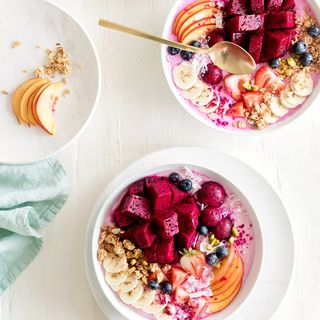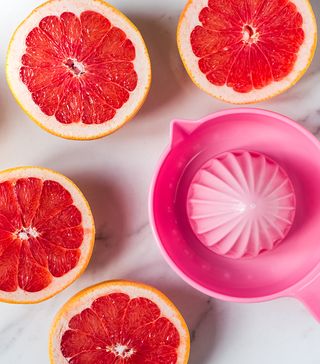Is This Food Trend the Next Millennial Pink?


Unless you've spent a large part of the past two years completely off the grid without any access to social media—and if that's the case, then bravo; you're probably better for it—you've likely noticed that light pink is the hue that the Instagram generation just can't quit. We snap our Glossier pouches and line up for photos in front of a punchy wall in West Hollywood; I dyed my hair pink last year and have recently felt the itch to do it again. And naturally, as is the destiny of any truly pervasive trend in our aesthetically driven culture, we're even more disposed to post (and consume) pink meals.
The good news is that nutritionally speaking, there's something to be said for seeking out rose-colored foods. "Adding color to your plate not only makes your food look more appealing, but it also mixes up the nutrients you give your body when you change the colors," says Amy Shapiro, a New York City–based nutritionist. "Red or pink foods typically contain lycopene and anthocyanins, both powerful antioxidants that help prevent blindness, prostate cancer, heart disease, and stroke. Many of these foods also have vitamin C, which helps with muscle recovery and can even aid in sleep."
Now, if we're splitting hairs, we can't technically label the food trend Millennial Pink—that calls for a specific shade of bubblegum-mauve, whereas the most nutritious pink foods favor a deeper, more saturated hue. (That's your indication that you're getting more vitamins and nutrients.) But they're Instagram-ready nonetheless, and the healthy options abound. "Foods I would recommend include strawberries, cranberries, watermelon, beets, dragon fruit, red meat, salmon, shrimp, and red grapes," says Shapiro.
From brightening skin to easing digestion, keep reading to learn more about the specific benefits of different pink foods.

Watermelon
"It's super high in lycopene, which is a strong antioxidant that fights cancer," says Shapiro. (And it's a welcome excuse to keep the summer vibes going all year.)
Red grapefruit
Consider this tart snack your first line of defense for cold-and-flu season. "It's high in vitamin C, which means it boosts immunity and helps counteract aging skin," says Shapiro. "It is also high in pectin, so it's great for the GI tract and decreasing cholesterol."

Beets
"They're high in folate, anthocyanins, and lycopene," says Shapiro. "That means they can be helpful in preventing birth defects and fighting disease, and can help with muscle recovery, too."
Raspberries
Raspberries are both extremely low in sugar and high in fiber—a winning combination if you're looking to lose or maintain your weight. "These are a great snack that helps with weight loss as well as energy, digestion, cholesterol reduction, and blood sugar regulation," says Shapiro.
Dragon Fruit
This Instagram-ready fruit boasts a spectrum of B and C vitamins, says Shapiro. It's also high in fiber.
Red Meat
Nope—it's not just about getting your fill of fruit and veggies. "Red meat is high in zinc, iron, and protein," notes Shapiro. "And grass-fed is high in omega-3 fatty acids. Eating red meat one time a week will help to decrease anemia, aid in muscle repair and growth, and can help protect the brain and skin."
It also rounds out a very photogenic (and very healthy) menu.
Next up, learn why cutting calories could be sabotaging your weight goals.
Disclaimer
This article is provided for informational purposes only and is not intended to be used in the place of advice of your physician or other medical professionals. You should always consult with your doctor or healthcare provider first with any health-related questions.

